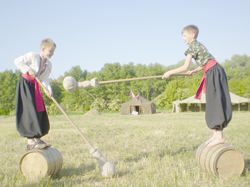Sich vacations
Cossack training instead of a Soviet-style camp
One can read countless legends, hear hundreds of narrations, see all the available movies about the Cossacks, but to experience true Cossack training seems something unachievable. And yet this is true for the Cossack Fortress Children Training Camp.
Every summer, for 20 years now, Ukrainian schoolchildren live like the real Cossacks in this camp — next to the places that played a key role in Ukrainian history, immersed in the traditions of knightly gallantry, surrounded by the tales about national heroes and the laws of friendship and fraternity, and learning the secrets of survival in tough conditions. In other words, instead of bland vacations in a tacky camp with a smack of Soviet times, the camp offers Cossack adventures in a picturesque Ukrainian locality with glorious historical background.
For example, this year the Cossack Fortress will be set up in the village of Pleskachivka, Smila raion, Cherkasy oblast, right next to Kholodnyi Yar, a legendary place that played a crucial role in Ukrainian history. This area is called “Small Switzerland” due to its beautiful landscapes featuring undulating hills, ponds, forests, meadows and salubrious water springs.
Volodymyr Sherstyuk, president of the Hopak Ukrainian Martial Arts School, says that since its inception the Cossack Fortress Camp has been set up in various localities in Ukraine, including Lviv, Kherson, Kharkiv, and Cherkasy oblasts.
“Every year we try to change the location to let kids visit various places in Ukraine and their nature and historical sites,” he says.
“The Cherkasy region has been famous for its Cossacks since the olden days. Last year the camp was pitched also in Cherkasy oblast, but in Chornobayi raion. We move around all the time to enable our children to learn as much as possible about the history of their homeland,” adds the Cossack Fortress quartermaster Viktor Ovcharenko.
Yes, quartermaster. There are no “leaders” here. The coaches here have the traditional Cossack ranks of company otaman, quartermaster, or flag-bearer. According to Sherstyuk, the training in the camp is based on the principles of Cossack pedagogy, which, in its turn, is based on traditional Ukrainian pedagogy. You can find its sources in the chronicle Povist’ vremennykh Lit (Tale of Bygone Years), Volodymyr Monomakh’s Poucheniie ditiam (Instruction for [My] Children), and Kievskaia Starina.
“The education practiced in the Sich was an achievement of the Ukrainian people’s pedagogy,” says Sherstyuk, “It is known, for instance, that children were educated through playing games. A game included both educational and physical development components. Their spiritual growth was achieved through a set of narrations, stories, and legends.”
The principles underlying the Cossack pedagogy, which is applied in the Cossack Fortress Camp, are vastly different from those which are characteristic of Ukrainian schools, where physical training is just a series of exercises without any energetic or philosophical components. An interesting and, one can say, unique element of the Cossack pedagogy is a focus on the child’s spiritual dimension. The young are taught to communicate with nature: with the sun, air, and water.
“We view spirituality as a process in which a person draws closer to nature,” specifies Volodymyr, “By nature, man is a kind of transmitter. We let energy, water, and information pass through us and transforms them into something new. That is why we explain to the children that when they greet the sun in the morning (through a special complex of exercises), the sunrays pass through the body cleansing it and filling it with vital energy.”
However, this is only a small part of the every-day activities awaiting the young Cossacks. In addition to playing games, doing physical exercises, and listening to stories about the Cossacks’ heroic exploits, there is time for archery, horse riding, the basics of the Cossack martial arts, hikes and excursions, arts classes, land navigation training, learning about herbs and traditional medicine, river crossing, boating, and learning survival skills in extreme conditions.
It is only natural that, according to the Hopak Ukrainian Martial Arts School’s website www.hopak.kiev.ua, all that “helps build national consciousness, pride in the people, personal independence and maturity.” Looks like a description of our glorious ancestors’ characteristic features.
The Cossack Fortress Camp is open for both boys and girls. According to Sherstiuk, special “girl” sessions include more gymnastics, stories about heroic women, embroidery, arts, appliqu , cooking, singing classes, folk symbol studies, and master classes on making wound dolls.
In the 20 years of their existence the Cossack training camps have educated an entire generation through distinct traditional Cossack pedagogy. Sherstiuk, who has been organizing training camps for 10 years, says that he feels like being on a special mission.
“The coaches are those who cultivate love for Ukraine in children treating them like their own kids. Those who have received training in the Cossack Fortress Camp are a generation of true Ukrainians. Their work, which they are trying to do for the benefit of Ukraine, is based on the worldview that was shaped in the camp.”






